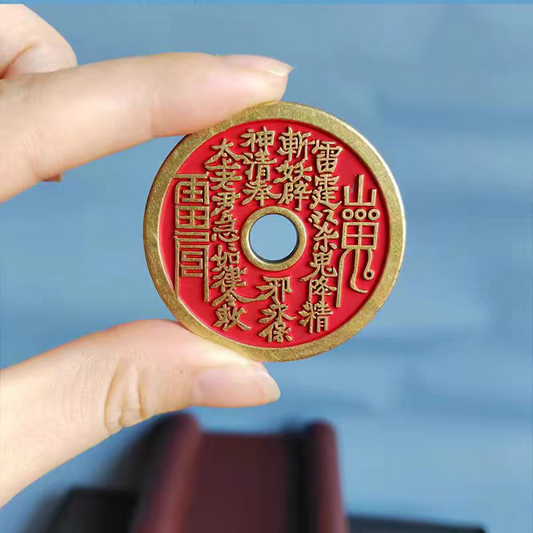Geschichte des Taoismus

Der Ursprung des Taisui-Glaubens
Tai Sui, ursprünglich ein fiktives Himmelswesen, das dem Jupiter (Sui Xing) zu kalendarischen Zwecken entsprach, entwickelte sich in der chinesischen Volksglaubenswelt zu einer gefürchteten Gottheit. Zur Zeit der Han-Dynastie galt...
Der Ursprung des Taisui-Glaubens
Tai Sui, ursprünglich ein fiktives Himmelswesen, das dem Jupiter (Sui Xing) zu kalendarischen Zwecken entsprach, entwickelte sich in der chinesischen Volksglaubenswelt zu einer gefürchteten Gottheit. Zur Zeit der Han-Dynastie galt...

Worin besteht der Unterschied zwischen Wenchang...
Wenchang Dijun und Wenqu Xingjun stehen beide für literarisches Schicksal, unterscheiden sich jedoch in Ursprung, Funktion und Symbolik. Wenchang, aus dem Sechs-Sterne-Sternbild Wen Chang, wacht über Gelehrtenkarrieren und den Staatsdienst....
Worin besteht der Unterschied zwischen Wenchang...
Wenchang Dijun und Wenqu Xingjun stehen beide für literarisches Schicksal, unterscheiden sich jedoch in Ursprung, Funktion und Symbolik. Wenchang, aus dem Sechs-Sterne-Sternbild Wen Chang, wacht über Gelehrtenkarrieren und den Staatsdienst....

Der erste Tag des achten Mondmonats: Der Tag, a...
Am 1. August des Mondkalenders stieg Xu Zhenjun auf – Drachentöter, Heiler von Seuchen, Gründer des Jingming Dao, dessen „Acht Tugenden“ die Unsterblichkeit durch kindliche Pietät leiten.
Der erste Tag des achten Mondmonats: Der Tag, a...
Am 1. August des Mondkalenders stieg Xu Zhenjun auf – Drachentöter, Heiler von Seuchen, Gründer des Jingming Dao, dessen „Acht Tugenden“ die Unsterblichkeit durch kindliche Pietät leiten.

Der Taoismus während der Zeit der Fünf Dynastien
Während der Zeit der Fünf Dynastien (907–960) erlebte der Taoismus eine Blütezeit. Lokale Herrscher verehrten ihn, Priester widmeten sich weltlichen Angelegenheiten und integrierten Ideen anderer Glaubensrichtungen. Die äußere Alchemie verlor...
Der Taoismus während der Zeit der Fünf Dynastien
Während der Zeit der Fünf Dynastien (907–960) erlebte der Taoismus eine Blütezeit. Lokale Herrscher verehrten ihn, Priester widmeten sich weltlichen Angelegenheiten und integrierten Ideen anderer Glaubensrichtungen. Die äußere Alchemie verlor...

Der Taoismus in seiner Reifephase während der n...
Während der Zeit der Nord- und Süd-Dynastien (420–589) erlebte der Taoismus seine Blütezeit. Kou Qianzhi reformierte den nördlichen Tianshi Dao, Lu Xiujing verbesserte den südlichen, und Tao Hongjing gründete die...
Der Taoismus in seiner Reifephase während der n...
Während der Zeit der Nord- und Süd-Dynastien (420–589) erlebte der Taoismus seine Blütezeit. Kou Qianzhi reformierte den nördlichen Tianshi Dao, Lu Xiujing verbesserte den südlichen, und Tao Hongjing gründete die...

Der Aufstieg des Taoismus in der östlichen Jin-...
In der Östlichen Jin-Dynastie erlebte der Taoismus eine Wiederbelebung. Ge Hongs „ Baopuzi: Innere Kapitel“ förderte die Theorien der Unsterblichkeit. Später entstanden Sekten wie Shangqing und Lingbao, die die taoistischen...
Der Aufstieg des Taoismus in der östlichen Jin-...
In der Östlichen Jin-Dynastie erlebte der Taoismus eine Wiederbelebung. Ge Hongs „ Baopuzi: Innere Kapitel“ förderte die Theorien der Unsterblichkeit. Später entstanden Sekten wie Shangqing und Lingbao, die die taoistischen...
Beliebte Kollektion
Die beliebtesten Anhänger taoistischer Kultivierender
-
Berggeist-Donnerlord-Segensmünzenanhänger
Normaler Preis $17.00 USDNormaler PreisGrundpreis / pro -
TAOIST REALTH SAMMELN TALISMAN GESCHÄFTSERFOLG 五路财神符
Normaler Preis $107.00 USDNormaler PreisGrundpreis / pro -
Talisman zur Abwehr von Katastrophen und zur Austreibung von Übeln 消灾驱邪符
Normaler Preis $107.00 USDNormaler PreisGrundpreis / pro -
Schwarzer Mythos: Wukong-Waffe, Jinggubang-Glücksbringer
Normaler Preis $39.00 USDNormaler PreisGrundpreis / pro$36.00 USDVerkaufspreis $39.00 USD -
Donner schlug im Jujube-Wald ein. Fünf heilige Berge. Diagramm des wahren Pfades. Acht Trigramme. Anhänger.
Normaler Preis $37.00 USDNormaler PreisGrundpreis / pro -
Blitzgepeitschte Jujube-Holz-Berggeistmünze Bagua-Energiefeld-Friedensanhänger
Normaler Preis $39.00 USDNormaler PreisGrundpreis / pro -
Consecrated Taoist Five Thunder Talisman Protect, Ward Off Disasters and Expel Evil Spirits 五雷符已开光
Normaler Preis $107.00 USDNormaler PreisGrundpreis / pro -
Taoistischer Glückstransfer-Talisman, Glückstransfer-Symbole
Normaler Preis $107.00 USDNormaler PreisGrundpreis / pro
Einführung in den Taoismus – Fragen und Antworten
Alle anzeigen-

The Grand Penitential Liturgy of the Jade Repos...
The Grand Penitential Liturgy of the Jade Repository: Late Tang master Du Guangting's expanded rite for directional confessions to Heavenly Worthies, repenting endless errors, erasing sins, and praying for imperial...
The Grand Penitential Liturgy of the Jade Repos...
The Grand Penitential Liturgy of the Jade Repository: Late Tang master Du Guangting's expanded rite for directional confessions to Heavenly Worthies, repenting endless errors, erasing sins, and praying for imperial...
-

Was ist „fuqi“ im Taoismus?
Fuqi: Die alte taoistische Kunst des „Qi-Tragens“ – im Einklang mit dem Kosmos atmen, Energie transformieren, den Körper heilen, den Geist beruhigen, den Geist durch rhythmische, achtsame Atmung erwecken.
Was ist „fuqi“ im Taoismus?
Fuqi: Die alte taoistische Kunst des „Qi-Tragens“ – im Einklang mit dem Kosmos atmen, Energie transformieren, den Körper heilen, den Geist beruhigen, den Geist durch rhythmische, achtsame Atmung erwecken.
-

Welche Talismane werden in taoistischen Rituale...
Daoistische Ritualsymbole: Wichtige Talismane wie Banner, Tür-, Lampen- und Zeremonialamulette, die in Riten verwendet werden, um Geister zu befehligen, zu heilen und Seelen zu führen.
Welche Talismane werden in taoistischen Rituale...
Daoistische Ritualsymbole: Wichtige Talismane wie Banner, Tür-, Lampen- und Zeremonialamulette, die in Riten verwendet werden, um Geister zu befehligen, zu heilen und Seelen zu führen.
-

Was ist der Dao?
Yin-Yang (陰陽) Die komplementären Kräfte, die Harmonie im Universum schaffen. Licht und Dunkelheit, Aktives und Passives, Männliches und Weibliches – alles ist miteinander verbunden.
Was ist der Dao?
Yin-Yang (陰陽) Die komplementären Kräfte, die Harmonie im Universum schaffen. Licht und Dunkelheit, Aktives und Passives, Männliches und Weibliches – alles ist miteinander verbunden.
















